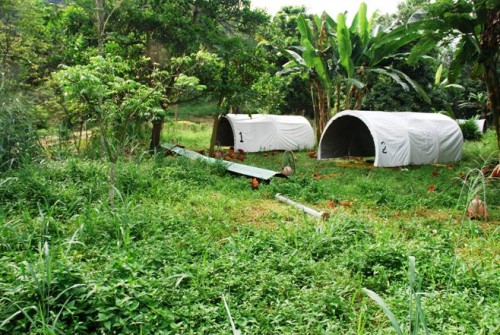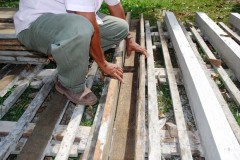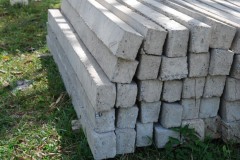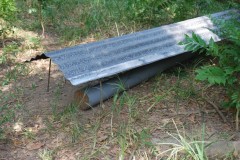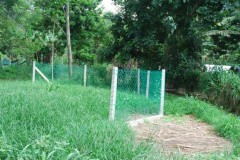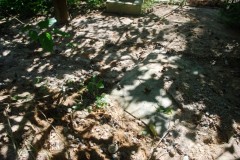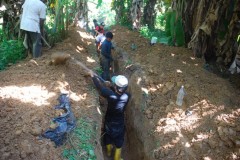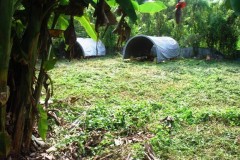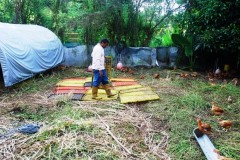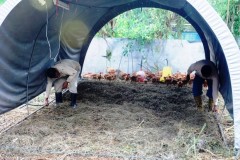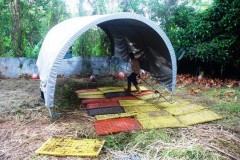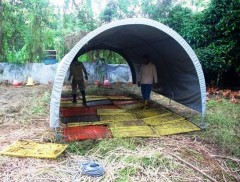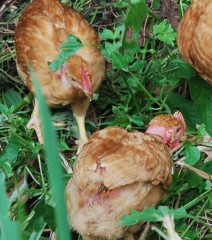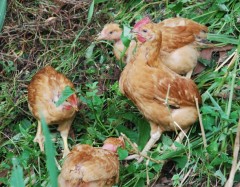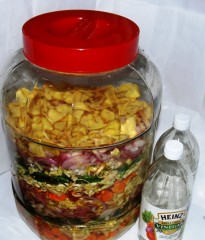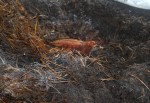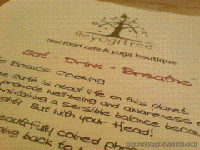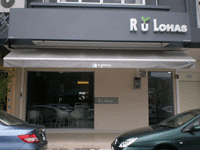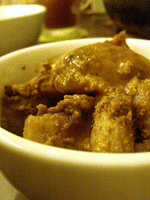Jan 31, 2011
Starting Free Range Chickens in Malaysia
Fixed houses (reban) where the chickens come out to range and go back in at night is not a good solution to free-ranging slow growing breeds in our wet, humid climate. As the chickens can take up to 100 days to reach marketable size, the area around the house would be foul in no time.
The solution is a movable tent, and fenced fields to keep moving the chickens onto fresh grounds.
These are how the fields look like in our farm:
These are the steps:
1. Fence up the area:
To save costs, make your own concrete posts. If you don't know how, learn. It's a skill worth learning. Wooden posts in Malaysia means cutting of jungle trees, termite problems, wood rot, etc. Concrete the bottom of the fence to keep out pigs. You can lose up to 30 chickens per night from a small family of pigs.
2. Make your own field feeders and drinkers:
You can't be a farmer without basic bar-bending and welding skills.
3. Have a stationary seine-net like area for catching the chickens:
We generally can have an area up and running for 1000 chickens within 10 days - two hoop houses, 30 field feeders, water tank and self-made line drinkers, and fencing and posts for an area that's equal to half an acre ( the grass will last about 20 days, then you have to shift the chickens to the next field. If you don't, the chickens will start having health problems).
14:51 Posted in Chickens | Permalink | Comments (4) | Tags: hoop houses, pastured poultry system, free-range chicken, organic chicken, ayam kampung
May 24, 2010
Raising Free Range Chickens - Watch That Water!!!
People ask me what is the most important thing that they have to watch out for in successful free-range poultry raising in Malaysia and I always answer : water!
Watch out for water in the litter
Water in the reban
Water under the reban
Water in the padang
Watch out for leaking pipes, even in the fields as the birds will drink from the leaked water which will become contaminated from the dung.
Watch out for the temperature of the water - it must always be colder than the surrounding air.
Above all the farm must be dry. With our humidity, a wet farm will raise humidity to 70% plus. That will bring with it many diseases.
We shape the land by creating swales, retention ponds and contours to move rain water to areas away from the fields and coops.
But sometimes the volume is just too great and we have no choice but to cut the earth and make drains. This is what happened to us over the weekend. There was a sudden huge downpour and the chicken fields were flooded. One particular field with marketable size chickens was flooded 3 feet and 407 chickens drowned. That's a revenue loss of about RM8000.
Mud everywhere blocking off culverts and drains.
A drain buried in mud.
A field covered with mud.
We had no alternative but to dig a huge earth drain to handle similar volume in future.
The weather at the farm have changed in the past few years and coupled with land clearing nearby, the farm has become a focal point of run-offs from these cleared areas.
Though the work was tiring, the workers were cheerful. they had fun catching the many wild eels in the farm for their lunch and dinner.
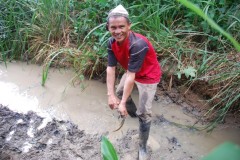
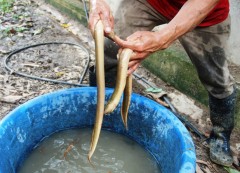
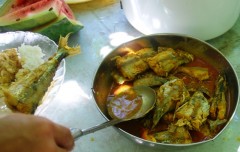
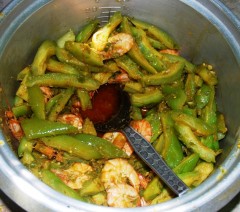
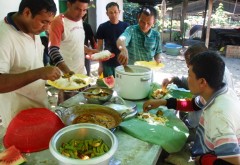
19:54 Posted in Chickens | Permalink | Comments (0) | Tags: hoop house, free-range chickens, crd, poultry disease, free range poultry system, grassfed chickens
May 10, 2010
Raising Free Range Chickens - Leave The Ammonia Behind!
Many readers write to us asking about diseases affecting their birds. However, many of these problems have to do with basic management, in particular the formation of ammonia(1) in their coops.
Initial signs of excessive ammonia include eye irritation and trachea and lung problems.
Subsequent to that, secondary infection sets in - mycoplasma for one, leading to chronic respiratory disease. Another common poultry problem is coryza resulting in a mad rush for antibiotics. Coryza, in the Malaysian context is often the result of exposure to ammonia which corrodes the mucous membrane allowing pathogens to gain entry into the body.
So the root cause is excessive ammonia and the solution to many diseases with symptoms like gasping, coryza, swollen eyes, etc is to manage ammonia production in your poultry system, rather than treat the end-result all the time, resulting in the abuse of antibiotics.
Ammonia production also leads to environmental issues - flies, smell, leachate, etc.
At our farm, we decided on a movable hoop house:
The hoop house design encourages air movement. The temperature difference within / outside the house can be as high as 2 degrees celcius.
The hoop house is moved every 7 to 10 days. During dry spells, 10 days. During rainy seasons, every 7 days. Feeders and waterers are moved every 3 days. Don't let dung and discarded food accumulate to form ammonia.
Lay down the bedding material.
The house can be pulled by one man if the move is on flat land. If it needs to be lifted, then two men is required.
Note that the old floor have been covered with dried grass to start the in-situ composting. In no time, humus will be formed.
Each hoop house is designed to shelter 300 800grams chickens from the sun and rain.
The house is moved in less than 15 mins. The chickens have clean fresh beds instantly. No necessity to remove litter and top up litter, etc resulting in labour and material costs savings.
DQ'S GOLDEN RULE : MOVE THE HOUSE, MOVE THE FEEDERS!! LEAVE THE AMMONIA BEHIND!!
Resulting in healthy, happy, nutritious chickens:
Birds are moved to the hoop house when they are 800 grams in size.
(1) The formation of ammonia is part of the natural process in the breakdown of organic material. Ammonium is poisonous and often wipe out a newly established aquarium of its fish. Industrial animal husbandry often raise animals in ammonia prone conditions - poultry, feedlotted cattle wading in their own dung, etc. Waste water from farms with animals often contain nitrites and nitrates which can also harm humans. At our farm all discharge is treated naturally and regularly tested for nitrite and nitrate levels as part of responsible farming.
17:13 Posted in Chickens | Permalink | Comments (1) | Tags: hoop house, free-range chickens, crd, poultry disease, free range poultry system, grassfed chickens
May 05, 2010
Tonic for Chickens
Some of the readers of this blog have asked me to write more on natural poultry rearing methods. This post is for readers of citypullagro and lopehpoultry and other poultry blogs.
At our farm we use this tonic for the chickens:
We use a large glass jar ('balang'). Do not use plastic. Here's the receipe:
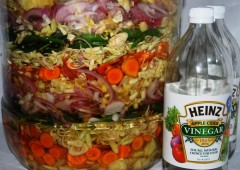
To Use
Indications
Notes:
17:50 Posted in Chickens | Permalink | Comments (4) | Tags: ayam kampung, poultry disease, poultry tonic, poultry medication
May 27, 2009
Carcasses - Compost 'em for Sustainability
The disposal of carcasses and animal wastes often pollutes the environment. In Malaysia, farms generally bury them or burn them.
At DQ, we compost them and return them to the soil as fertiliser and as soil amendment. We have innovated our own method of composting carcasses, after much trial and error, as follows:
Lay the carcasses and wastes in layers and between the layers, cover them with carbon material such as dried lallang, leaves, etc. We generally require the abdomen of all carcasses to be opened to prevent inadvertently creating anaerobic conditions from forming inside the carcasses which may result in the formation of toxins.
Lactobacillus is sprayed on the layers to speed up the heating process. Lactobacillus is a medium heat microbe and works well and fast at our ambient temperature of around 30 celcius. Within a day they will bring the temperature of the heap to 45 celcius for the thermophilics to take over.

With enough moisture and oxygen, actinomycetes will jump into action almost immediately breaking down the materials in the heap and giving the characterisitic "earth" smell to your compost at the end.
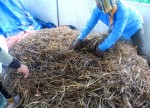
Cover up the pile neatly to retain the heat for the thermophilics to do their work thoroughly.
After a couple of days, the heat generated will be sufficient to cook an egg in a short while. Or to cook beef:
65 celcius - hot enough to cook beef.
The pile or heap should be turned a minimum of two times to ensure that as much of the material has gone through the heating process to destroy pathogens and even some toxins. At DQ this process will take 30 days.
After that, we introduce local composting earthworms to turn the compost to humus / vermicast. The composting earthworms ( eisenia fetida) works pretty fast, within 10 days they will have a few inches of vermicast for you to collect and use.
( Do not use imported earthworms as there are millions of microbes in the guts of earthworms and you may be introducing 'aliens' to our environment).
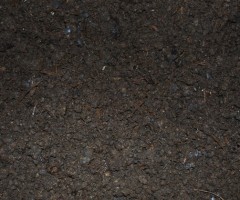
Beautiful black humus in just 40 days. The end result is a microbes-rich fertiliser suitable to be used as a soil fertiliser, as an amendment or as a foliar spray. We use this humus to build up sandy soil, as an anti-fungal, as fertiliser and generally to return to the soil what has been taken from it.
If you are already applying some other organic fertiliser, the addition of humus made the DQ way at a rate of 100kg per acre to acre and a half will see a 10 to 15 percent improvement in yields. And that's 10 to 15% straight to the bottom line as the inputs used are generally free!
17:23 Posted in Chickens | Permalink | Comments (5) | Tags: compost, carcasses, sustainable agriculture, organic farming
Feb 17, 2009
Cold Chain - Don't Lose It!
One of the most important food safety precautions is keeping the Cold Chain intact. Since 2001 when we first started we noticed many fresh poultry suppliers giving scant consideration to this very important food safety concern. The delivery truck is extremely important in our hot climate. Our truck runs at - 5 degrees celcius. Yes, it is below freezing point, but what many suppliers do not realise is that each time the truck stops and unloads, the surface temperature of the meat product is affected, allowing for the growth of bacteria.
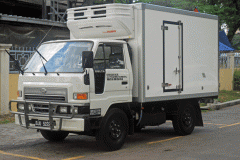
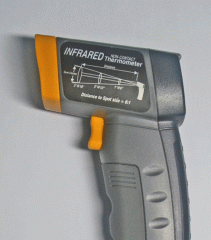
17:08 Posted in Chickens | Permalink | Comments (0) | Tags: cold chain, food safety, frozen food temperature, infrared thermometer
Feb 07, 2009
Eggs - There IS a difference!
We sent eggs previously, a few years back to test for omega 3. In particular we were interested in the omega 6: omega 3 ratio. We were not surprised to find 'ayam kampung' eggs and 'organic' eggs having ratios of 20 to 1. We were focussing on the omega 6: omega 3 ratio and not on questions like whether the eggs are free-ranging or not, really organic or not, etc.
As a result of the tests, we wanted to produce our own eggs. We have been doing trials on grass fed, free-range eggs for a few months now and we were surprised that physically there seems to be a difference:
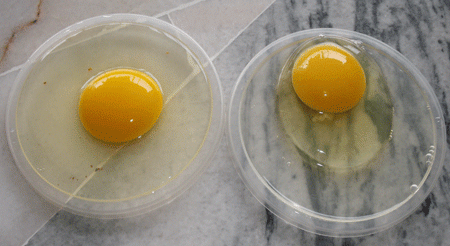
The left egg is a normal egg bought from a supermarket. The expiry date is another 14 days away
The egg on the right is a DQ egg which has been in the refridgerator for 10 days. The supermarket egg is a full 30% bigger.
The white of the supermarket egg is all over and watery. The DQ egg has a thicker white around the yolk, and lesser watery white.
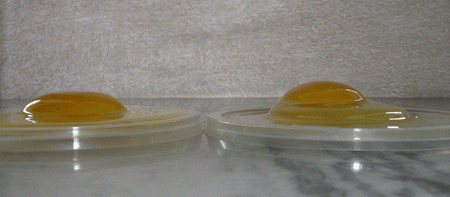
The DQ yolk and albumen stands up, whilst the supermarket egg flattens out.
We are surprised that there are physical differences. We do not know what these differences mean. A friend said it just means that the supermarket egg is less fresh and could be stale. Stale? With the expiry 14 days away?
We will be sending our eggs for omega 6: omega 3 ratio tests and keep this blog posted.
PS: This is the Lady that laid the egg:
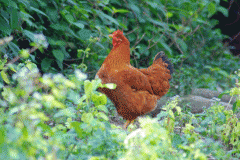
23:52 Posted in Chickens | Permalink | Comments (3) | Tags: organic eggs, eggs, omega 3, dha
Jan 29, 2009
Restaurants Using DQ Chicken

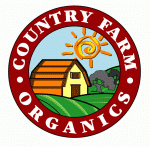




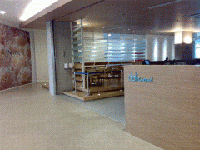



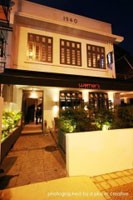

21:08 Posted in Chickens | Permalink | Comments (0) | Tags: poultry, restaurants, organic meals, receipes
Jan 23, 2009
What do we feed the chickens?
So, what do we feed the chickens? Grass of course. We seeded over 30 varieties of grasses, legumes, and plants in the fields. We selected them for protein, for omega 3 and for antioxidants.
Then, we supplement by cooking for them! Yes, we cook for our chickens to give you the best, most flavorful, nutritious chicken you can find in the world:

These huge cauldrons, or kawahs ("crater kuali") are used to cook for the chickens. What do we cooked? The final mix is a secret, but we have banana piths, old-type non-GMO jagung, ubi, sago and lots of tilapia from our own ponds.
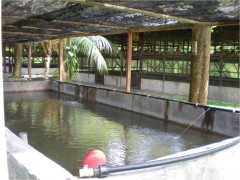
Here's a pond next to the reban to cool down the chickens while trapping the flies and insects as free protein for the fish.
00:33 Posted in Chickens | Permalink | Comments (0) | Tags: grassfed, free range, organic chickens
Permanent Free Range?
What's with our claim that our chickens are "Permanent Free Range"?
In some countries, free range is defined as having "access to outdoors". So, if you have lots of little doors for the chickens to go out, and yet you place all the feeders inside so that the chickens seldom if ever go out, you can still validly say your chickens are free range. In Malaysia, free range can mean hanging around a permanent reban which the chickens retire to during the night. The grounds will be smelly, dirty, full of flies.
Our permanent free range chickens are raised in fresh fields with movable coops being used to move them from padang to padang. They never go back to a reban. They are moved from fresh field to fresh field, and when the time come for them to be harvested, they are on fresh fields, not muddy smelly bacteria infested grounds.
We are the only farmer in the world using these heat-insulated movable, dismantleable field houses. One man can pull the tent to a fresh field once the existing field becomes dirty.
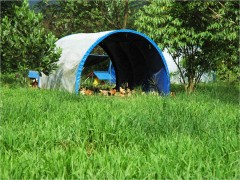
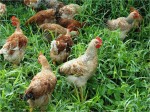
00:13 Posted in Chickens | Permalink | Comments (2) | Tags: grassfed, free range, organic chickens








